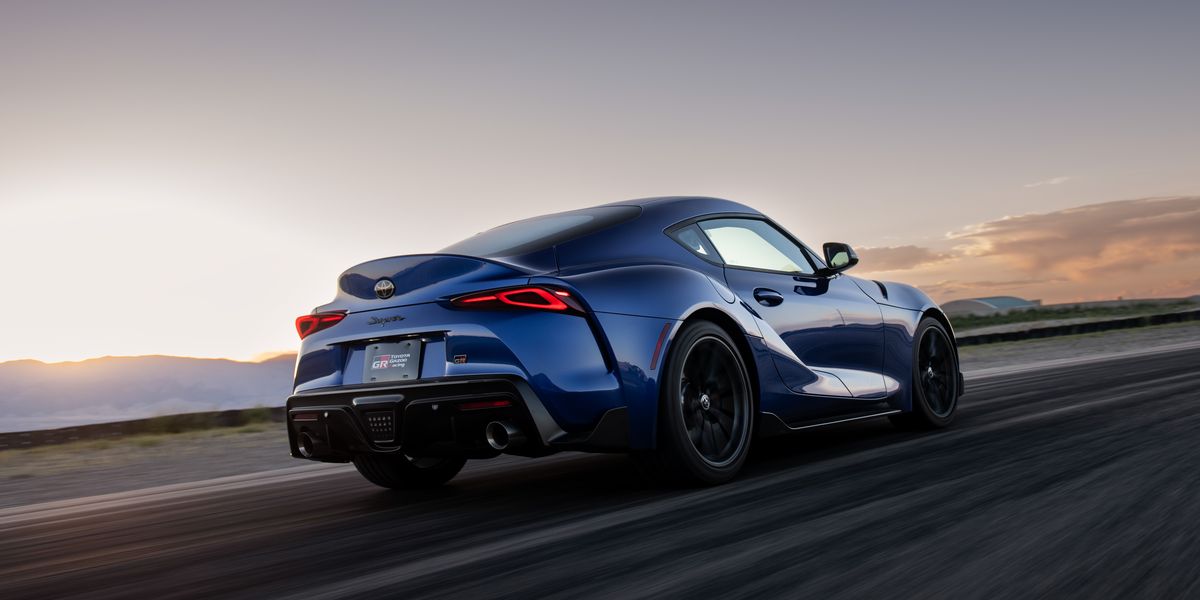2023 Toyota GR Supra 3.0 Manual Answers Our Pleas

As soon as the current Supra was introduced for the 2020 model year, the calls flooded Toyota’s PR desk: Where’s the manual-transmission version? For many enthusiasts, something just didn’t sit right about such a legendary nameplate at the top of the brand’s Gazoo Racing–developed lineup being available only with an automatic. Fortunately, Toyota heeded the call to save the manuals, introducing a stick-shift Supra for 2023, and it’s as good as we’d hoped.
Available as a no-cost option on the 3.0 and 3.0 Premium models, the new six-speed stick mates solely to the Supra’s lovely 382-hp turbocharged 3.0-liter inline-six. The base turbo 2.0-liter four remains automatic only. Pricing kicks off at $53,595. There also will be a 500-unit run of A91-MT special editions, which for $59,440 add model-exclusive paint options and trim, plus a cabin dressed in fetching tan leather upholstery.
Given the Supra’s gestation alongside the still-automatic-only BMW Z4 roadster, Toyota had to get creative in packaging the manual setup. Slip inside the snug cabin and you might notice that the infotainment controller wheel has moved to the far right of the center console, making room for a shift lever situated within easy reach yet precariously close to the dash’s center stack. Get too aggressive upshifting into third gear and you’ll rap your knuckles on the climate controls. Similarly, your elbow might knock into anything sticking out of the center armrest’s cupholders. Real estate is also at a premium in the driver’s footwell, with little room to spare between the closely spaced pedals. But it all works to bring greater precision and enjoyment to an already exciting sports car.
Manual-equipped cars get a shorter final-drive ratio—3.46:1 versus the eight-speed auto’s 3.15:1—which together with the long, linear travel of the clutch pedal makes setting off easy. The weighting of the left pedal helps with metering its takeup yet is light enough not to induce leg cramps. Automatic rev matching is on by default, and the feature worked well on our laps around the twisty Utah Motorsports Campus. It can be deactivated when configuring the Individual mode. And you’ll want to turn it off, because the placement of the pedals is ideal for effortless heel-and-toe downshifts, no matter your driving style.
The action of the shifter, with its small-diameter shift ball and narrow gates, is equally precise. Gears engage with satisfying resistance, like greased ball joint popping into socket. Most important, though, is the greater integration all of this brings to the Supra’s driving experience—timing shifts, managing wheelspin, and better manipulating the car’s balance. As good as the car’s ZF-sourced automatic is, shifting your own gears will always be more fun. Rip through the ratios and you’re more aware of both the turbo six’s surge of low-end torque (368 lb-ft at 1800 rpm) and the strong pull to its 7000-rpm redline. Coordinate a perfect 3-2 downshift while the car is squirming under hard braking and the smiles simply come more easily.
To aid the transition, Toyota has retuned the manual car’s traction-control system and tweaked the stability control on all 3.0 models to rein in the Supra’s tendency to rotate when the driver abruptly lifts off the accelerator in corners. A new Hairpin+ function relaxes the standard electronically controlled limited-slip differential in ultratight bends. Six-cylinder versions also receive updates to their electrically assisted steering and revised adaptive dampers aimed at improving ride comfort and body control. We’ll need more seat time to weigh in on how impactful these changes are, but they don’t make the Supra any less entertaining to master.
As for the transmission itself, Toyota optimized an existing ZF six-speed unit for the Supra by removing some sound-deadening elements and fitting a larger, reinforced clutch assembly. Weight savings versus the automatic are a claimed 22 pounds, with the manual car weighing a quoted 3389 pounds. But the mechanics of DIY shifting will almost certainly add a few tenths of a second to the automatic version’s 3.8-second 60-mph time. Likewise, the manual’s fuel economy will undoubtedly trail the autobox’s figure. But after finally experiencing the latest Supra as the sports-car gods intended, we wouldn’t have ours any other way.
A car-lover’s community for ultimate access & unrivaled experiences. JOIN NOW




